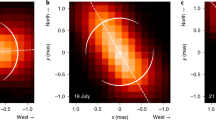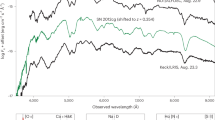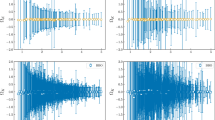Abstract
While gravitational microlensing by planetary systems1,2 provides unique vistas on the properties of exoplanets3, observations of a given two-body microlensing event can often be interpreted with multiple distinct physical configurations. Such ambiguities are typically attributed to the close–wide4,5 and inner–outer6 types of degeneracy, which arise from transformation invariances and symmetries of microlensing caustics. However, there remain unexplained inconsistencies (see, for example, ref. 7) between the aforementioned theories and observations. Here, leveraging a fast machine learning inference framework8, we present the discovery of the offset degeneracy, which concerns a magnification-matching behaviour on the lens axis and is formulated independently of caustics. This offset degeneracy unifies the close–wide and inner–outer degeneracies, generalizes to resonant topologies and, upon reanalysis, not only appears ubiquitous in previously published planetary events with twofold degenerate solutions, but also resolves prior inconsistencies. Our analysis demonstrates that degenerate caustics do not strictly result in degenerate magnifications and that the commonly invoked close–wide degeneracy essentially never arises in actual events. Moreover, it is shown that parameters in offset-degenerate configurations are related by a simple expression. This suggests the existence of a deeper symmetry in the equations governing two-body lenses than previously recognized.
This is a preview of subscription content, access via your institution
Access options
Access Nature and 54 other Nature Portfolio journals
Get Nature+, our best-value online-access subscription
$29.99 / 30 days
cancel any time
Subscribe to this journal
Receive 12 digital issues and online access to articles
$119.00 per year
only $9.92 per issue
Buy this article
- Purchase on Springer Link
- Instant access to full article PDF
Prices may be subject to local taxes which are calculated during checkout



Similar content being viewed by others
Data availability
Source data for Figures 2 and 3 have been made available online. Figure 3 data are also partially available in the NASA microlensing exoplanet archive, https://exoplanetarchive.ipac.caltech.edu.
Code availability
This work utilized the public microlensing code, MulensModel47, available at https://github.com/rpoleski/MulensModel.
References
Mao, S. & Paczyński, B. Gravitational microlensing by double stars and planetary systems. Astrophys. J. Lett. 374, L37 (1991).
Gould, A. & Loeb, A. Discovering planetary systems through gravitational microlenses. Astrophys. J. 396, 104–114 (1992).
Gaudi, B. S. Microlensing surveys for exoplanets. Annu. Rev. Astron. Astrophys. 50, 411–453 (2012).
Griest, K. & Safizadeh, N. The use of high-magnification microlensing events in discovering extrasolar planets. Astrophys. J. 500, 37 (1998).
Dominik, M. The binary gravitational lens and its extreme cases. Astron. Astrophys. 349, 108–125 (1999).
Han, C. et al. MOA-2016-BLG-319Lb: microlensing planet subject to rare minor-image perturbation degeneracy in determining planet parameters. Astron. J. 156, 226 (2018).
Yee, J. C. et al. OGLE-2019-BLG-0960 Lb: the smallest microlensing planet. Astron. J. 162, 180 (2021).
Zhang, K. et al. Real-time likelihood-free inference of Roman binary microlensing events with amortized neural posterior estimation. Astron. J. 161, 262 (2021).
Choi, J.-Y. et al. A new type of ambiguity in the planet and binary interpretations of central perturbations of high-magnification gravitational microlensing events. Astrophys. J. 756, 48 (2012).
Cranmer, K., Brehmer, J. & Louppe, G. The frontier of simulation-based inference. Proc. Natl Acad. Sci. USA 117, 30055–30062 (2020).
Penny, M. T. et al. Predictions of the WFIRST microlensing survey I: bound planet detection rates. Astrophys. J. Suppl. 241, 3 (2019).
Campello, R. J. G. B., Moulavi, D. & Sander, J. in Advances in Knowledge Discovery and Data Mining (eds Pei, J. et al.) 160–172 (Lecture Notes in Computer Science, Springer, 2013).
Herrera-Martin, A. et al. OGLE-2018-BLG-0677Lb: a super-Earth near the Galactic bulge. Astron. J. 159, 256 (2020).
An, J. On the condition for the central caustic degeneracy of the planetary microlensing. Preprint at http://arxiv.org/abs/2102.07950 (2021).
Chang, K. & Refsdal, S. Star disturbances in gravitational lens galaxies. Astron. Astrophys. 132, 168–178 (1984).
Gaudi, B. S. & Gould, A. Planet parameters in microlensing events. Astrophys. J. 486, 85–99 (1997).
Zang, W. et al. KMT-2016-BLG-1397b: KMTNET-only discovery of a microlens giant planet. Astron. J. 156, 236 (2018).
Gould, A. et al. Frequency of Solar-like systems and of ice and gas giants beyond the snow line from high-magnification microlensing events in 2005–2008. Astrophys. J. 720, 1073–1089 (2010).
Davies, A. et al. Advancing mathematics by guiding human intuition with AI. Nature 600, 70–74 (2021).
Bennett, D. P. & Rhie, S. H. Simulation of a space-based microlensing survey for terrestrial extrasolar planets. Astrophys. J. 574, 985–1003 (2002).
Yeo, I.-K. A new family of power transformations to improve normality or symmetry. Biometrika 87, 954–959 (2000).
Gerber, F. & Furrer, R. optimParallel: an R package providing a parallel version of the L-BFGS-B optimization method. R J. 11, 352–358 (2019).
Byrd, R. H., Lu, P., Nocedal, J. & Zhu, C. A limited memory algorithm for bound constrained optimization. SIAM J. Sci. Comput 16, 1190–1208 (1995).
Skowron, J. et al. OGLE-2017-BLG-0373Lb: a Jovian mass-ratio planet exposes a new accidental microlensing degeneracy. Acta Astron. 68, 43–61 (2018).
Janczak, J. et al. Sub-Saturn planet MOA-2008-BLG-310Lb: likely to be in the Galactic bulge. Astrophys. J. 711, 731–743 (2010).
Hirao, Y. et al. OGLE-2012-BLG-0724Lb: a Saturn-mass planet around an M dwarf. Astrophys. J. 824, 139 (2016).
Nagakane, M. et al. MOA-2012-BLG-505Lb: a super-Earth-mass planet that probably resides in the Galactic bulge. Astron. J. 154, 35 (2017).
Suzuki, D. et al. MOA-2008-BLG-379Lb: a massive planet from a high magnification event with a faint source. Astrophys. J. 780, 123 (2014).
Dong, S. et al. Microlensing event MOA-2007-BLG-400: exhuming the buried signature of a cool, Jovian-mass planet. Astrophys. J. 698, 1826–1837 (2009).
Herrera-Martín, A. et al. OGLE-2018-BLG-0677Lb: a super-Earth near the Galactic bulge. Astron. J. 159, 256 (2020).
Rattenbury, N. J. et al. Faint-source-star planetary microlensing: the discovery of the cold gas-giant planet OGLE-2014-BLG-0676Lb. Mon. Not. R. Astron. Soc. 466, 2710–2717 (2017).
Bond, I. A. et al. The lowest mass ratio planetary microlens: OGLE 2016-BLG-1195Lb. Mon. Not. R. Astron. Soc. 469, 2434–2440 (2017).
Bennett, D. P. et al. MOA data reveal a new mass, distance, and relative proper motion for planetary system OGLE-2015-BLG-0954L. Astron. J. 154, 68 (2017).
Hirao, Y. et al. OGLE-2013-BLG-1761Lb: a massive planet around an M/K dwarf. Astron. J. 154, 1 (2017).
Han, C. et al. OGLE-2016-BLG-0263Lb: microlensing detection of a very low-mass binary companion through a repeating event channel. Astron. J. 154, 133 (2017).
Hwang, K.-H. et al. KMT-2016-BLG-1107: a new Hollywood-planet close/wide degeneracy. Astron. J. 157, 23 (2019).
Han, C. et al. Four microlensing planets with faint-source stars identified in the 2016 and 2017 season data. Astron. Astrophys. 642, A110 (2020).
Ranc, C. et al. OGLE-2015-BLG-1670Lb: a cold Neptune beyond the snow line in the provisional WFIRST microlensing survey field. Astron. J. 157, 232 (2019).
Nucita, A. A. et al. Discovery of a bright microlensing event with planetary features towards the Taurus region: a super-Earth planet. Mon. Not. R. Astron. Soc. 476, 2962–2967 (2018).
Han, C. et al. Three microlensing planets with no caustic-crossing features. Astron. Astrophys. 650, A89 (2021).
Kim, Y. H. et al. KMT-2019-BLG-0371 and the limits of Bayesian analysis. Astron. J. 162, 17 (2021).
Han, C. et al. OGLE-2016-BLG-1227l: a wide-separation planet from a very short-timescale microlensing event. Astron. J. 159, 91 (2020).
Han, C. et al. KMT-2019-BLG-1339L: an M dwarf with a giant planet or a companion near the planet/brown dwarf boundary. Astron. J. 160, 64 (2020).
Miyazaki, S. et al. MOA-2015-BLG-337: a planetary system with a low-mass brown dwarf/planetary boundary host, or a brown dwarf binary. Astron. J. 156, 136 (2018).
Hwang, K.-H. et al. Systematic KMTNet Planetary Anomaly Search, paper II: five new q < 2 × 10−4 mass-ratio planets. Astron. J. 163, 43 (2022).
Bozza, V. Perturbative analysis in planetary gravitational lensing. Astron. Astrophys. 348, 311–326 (1999).
Poleski, R. & Yee, J. C. Modeling microlensing events with MulensModel. Astron. Comput. 26, 35–49 (2019).
Acknowledgements
K.Z. thanks the LSSTC Data Science Fellowship Program, which is funded by LSSTC, NSF Cybertraining grant 1829740, the Brinson Foundation and the Moore Foundation; his participation in the programme has benefited this work. K.Z. and J.S.B are supported by a Gordon and Betty Moore Foundation Data-Driven Discovery grant. Work by B.S.G. is supported by NASA grant NNG16PJ32C and the Thomas Jefferson Chair for Discovery and Space Exploration. We thank E. Agol and J. Lu for helpful comments on a draft of this Letter.
Author information
Authors and Affiliations
Contributions
K.Z. and J.S.B. conceived of the degeneracy-finding search. K.Z. implemented the search and identified the offset degeneracy. J.S.B. designed and wrote the code for the cluster-finding approach. B.S.G. aided in the study and interpretation of the LFI-derived posteriors of microlensing events and helped to develop the interpretation of the offset degeneracy and place it in the context of results from the literature. K.Z., B.S.G. and J.S.B. co-wrote the manuscript.
Corresponding author
Ethics declarations
Competing interests
The authors declare no competing interests.
Peer review
Peer review information
Nature Astronomy thanks Przemek Mróz and the other, anonymous, reviewer(s) for their contribution to the peer review of this work.
Additional information
Publisher’s note Springer Nature remains neutral with regard to jurisdictional claims in published maps and institutional affiliations.
Extended data
Extended Data Fig. 1 Caustics shown in green atop of maps of magnification differences from a 1-body lens, for wide (top), resonant (middle), and close (bottom) caustic topologies.
Red dots indicate locations of the planet, with separations s = 1/0.8, 1, 0.8 from the host star, located at the origin. The mass-ratio is fixed at q = 2 × 10−3. Blue dashed lines represent the Einstein ring θE, the angular size to which the projected separation (s) is normalised. Caustic topologies are delineated by values of s for a given q. In the wide regime (s ≳ 1 + (3/2)q1/3), there is one central caustic located near the host star and one asteroid-shaped ‘planetary’ caustic towards the location of the planet. In the close regime (s ≲ 1 − (3/4)q1/3), there are two small, triangular shaped ‘planetary’ caustics in addition to the central caustic that appears similar to the wide central caustic, due to the close-wide degeneracy. For values of s in between these regimes, there is one six-cusped ‘resonant’ caustic. For all cases, there are lobes of excess magnification compared to a point lens near caustic cusps, and lobes of de-magnification towards the back-end of the central/resonant caustic.
Extended Data Fig. 2 The manifestation of the offset degeneracy in source-plane magnification difference maps (top) and light curves (bottom) for fixed sB = 1.18 > 1.
This completes the resonant-close (b) and wide-topology inner-outer (d) cases.
Extended Data Fig. 3 The manifestation of the offset degeneracy in source-plane magnification difference maps (top) and light curves (bottom) for fixed sB = 1.
(i)–(p) shows logarithmic deviations from PSPL on arbitrary scales, where green dashed curves are the changing lens A and sold blue curves are for fixed lens B. (a)–(d) and (e)–(h) show the same sequence of sA but for q = 10−3 and q = 10−2 to illustrate how the offset degeneracy generalises to larger mass-ratios. (a,e) reveals that the ring structure of the null is composed of two distinct null segments, where one appears to originate from the centre of the central/resonant caustic and the other from the left two cusps of the same caustic. Closer inspection shows that the null rings for (a) and (e) have different topologies: for (a) it is the left part of the null that intersects on the star–planet axis but for (e) it is the right part. This disjoint topology of the null is also seen in Fig. 1 and Extended Data Figure 4&5. The topology transition point, presumably a function of s and q, may have mathematical implications for the offset degeneracy. Furthermore, we observe that the null segment near the star–planet axis becomes increasingly curved for \(| \log (s)| \gg 0\) and q → 1, which may explain how Equation 1 and the offset degeneracy in general, may break down in those limits.
Extended Data Fig. 4 Magnification difference maps zoomed-in on the central caustic. Same sB = 1/1.1 as Fig. 1.
Cyan arrows indicate the location of the null. For (b) and (c), the null always crosses the two caustics at their intersection.
Extended Data Fig. 5 Magnification difference maps which demonstrates the offset degeneracy independence on q for q ≪ 1.
Lens B shares the same fixed sB = 1.1 as in Fig. 1. Each row shows cases of sA = 0.95, 1, 1.16 for q = 10−2, 10−4, 10−6. The null location predicted from Equation 1 is shown in cyan crosses. For q = 10−4 and q = 10−6, the null shape largely remains constant where the null intersection on the star–planet axis is well predicted by the analytic prescription (Equation 1). The three cases of q = 10−2 demonstrate how the behaviour of the null changes as q → 1. In the case of sA = 1.16, the null is split into two disconnected segments inside and outside of the caustic, where the analytic prediction is close to their mean location. For sA = 0.95, the discrepancy from the analytic prediction may be attributed to the curvature of the null near the star–planet axis.
Source data
Source Data Fig. 2
Source Data.
Source Data Fig. 3
Source Data.
Rights and permissions
About this article
Cite this article
Zhang, K., Gaudi, B.S. & Bloom, J.S. A ubiquitous unifying degeneracy in two-body microlensing systems. Nat Astron 6, 782–787 (2022). https://doi.org/10.1038/s41550-022-01671-6
Received:
Accepted:
Published:
Issue Date:
DOI: https://doi.org/10.1038/s41550-022-01671-6
This article is cited by
-
AI providing new light on lensing degeneracies
Nature Astronomy (2022)



